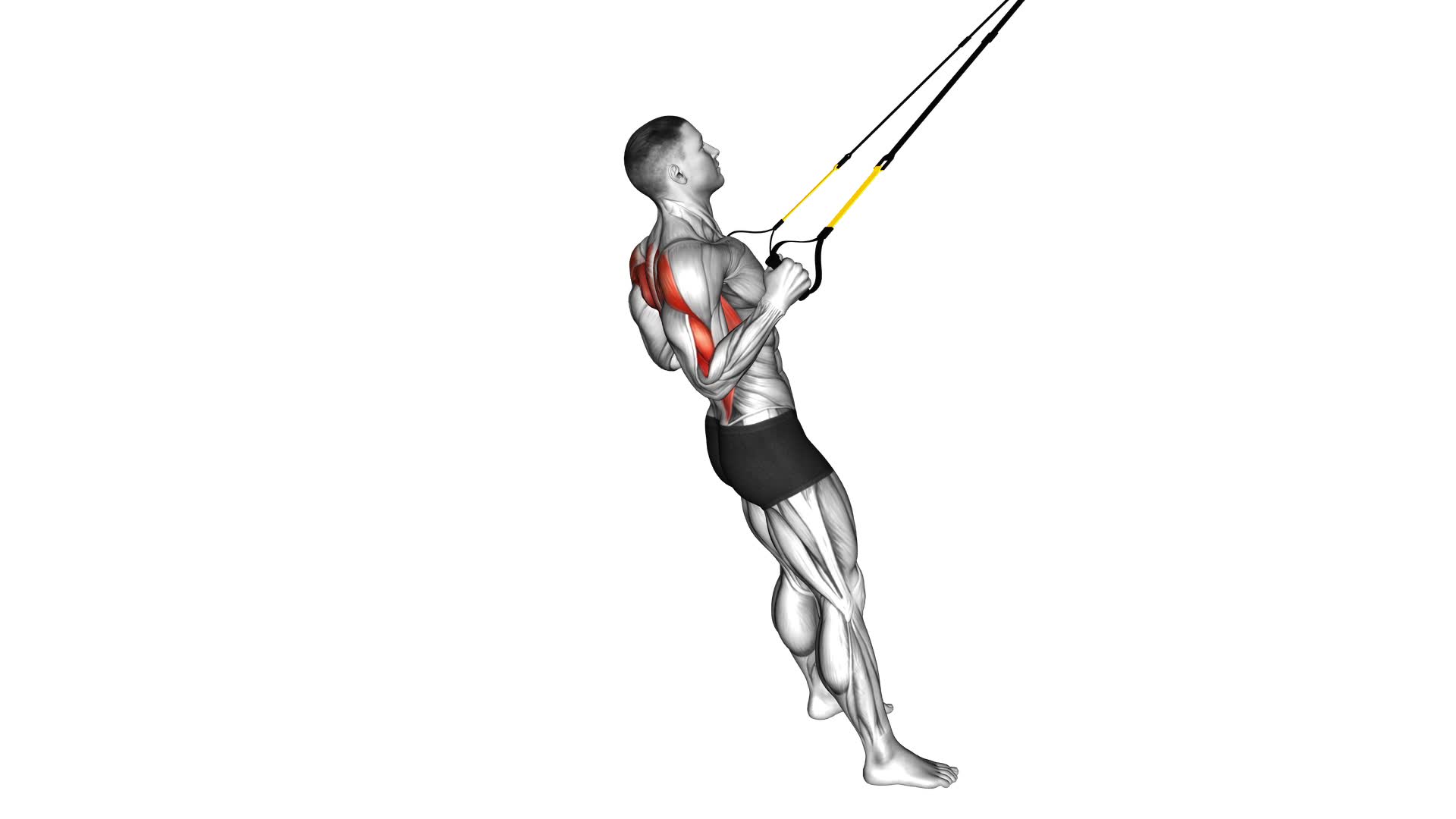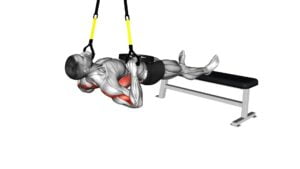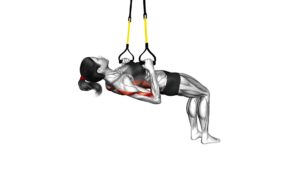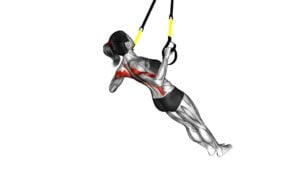Suspender Row (male) – Video Exercise Guide & Tips

Get ready to take your workout to the next level with the Suspender Row. This video exercise guide is here to help you achieve maximum results.
Watch This Exercise Video
Learn the proper form and technique, as well as common mistakes to avoid. With tips for progression and variation, you'll never get bored.
Get ready to feel the burn and see the gains with this effective exercise. Let's get started!
Key Takeaways
- Suspender rows improve upper body strength and endurance.
- Proper form and technique, such as keeping the elbows close to the body and engaging the back muscles, are crucial for maximum effectiveness.
- Engaging the core muscles and maintaining a straight spine and pulled back, down shoulders during the exercise enhances stability and prevents injury.
- There are various ways to progress and vary the exercise, such as increasing resistance, trying single-arm rows, performing inclined rows, and incorporating tempo variations.
Benefits of Suspender Row
To fully reap the benefits of the Suspender Row exercise, you should focus on engaging your core and upper body muscles with controlled and deliberate movements. This exercise primarily targets your back muscles, specifically the latissimus dorsi, rhomboids, and trapezius. By regularly incorporating the Suspender Row into your workout routine, you can experience numerous benefits.
One of the key benefits of the Suspender Row is improved upper body strength. As you pull your body towards the suspension point, your back muscles work hard to control the movement, leading to increased strength and muscle definition. Additionally, this exercise also engages your core muscles, helping to improve stability and posture.
Another benefit of the Suspender Row is increased upper body endurance. By performing multiple repetitions of this exercise, you can build endurance in your back and upper body muscles, allowing you to perform other exercises more efficiently.
To maximize the benefits of the Suspender Row, it's important to maintain proper form throughout the exercise. Make sure to keep your core engaged and your back straight. Focus on pulling your shoulder blades together as you perform the rowing motion.
Equipment Needed for Suspender Row
To properly perform the Suspender Row exercise and maximize its benefits, you'll need the following equipment:
- Suspender: This is the main piece of equipment needed for the Suspender Row exercise. Make sure to choose a suspender that's sturdy and can support your body weight. It should also have adjustable straps to accommodate different heights and arm lengths.
- Pull-up Bar: A pull-up bar is essential for performing the Suspender Row exercise. Look for a pull-up bar that can be securely mounted on a wall or door frame. Make sure it can hold your body weight and provides enough space for you to fully extend your arms during the exercise.
- Exercise Mat: Although not strictly necessary, an exercise mat can provide added comfort and support during the Suspender Row exercise. It can help cushion your knees and elbows, reducing the risk of discomfort or injury.
Proper equipment is crucial for performing the Suspender Row exercise effectively and safely. Using the right suspender, pull-up bar, and exercise mat will ensure that you can maintain proper form and technique throughout the exercise, maximizing its benefits and minimizing the risk of injury.
Proper Form and Technique for Suspender Row
To perform the Suspender Row exercise with proper form and technique, it's important to pay attention to the position of your elbows. Keep them close to your body and avoid letting them flare out.
Engage your back muscles throughout the exercise by pulling your shoulder blades together.
Be mindful of common mistakes such as using momentum or relying too much on your arms.
Elbows Position Importance
Start by ensuring that your elbows are in the correct position for proper form and technique during the Suspender Row exercise. Proper alignment of the elbows is crucial for maintaining shoulder stability and maximizing the effectiveness of this exercise. Here are some key points to keep in mind:
- Align your elbows directly under your shoulders.
- Keep your elbows tucked in close to your body.
- Avoid allowing your elbows to flare out to the sides.
By maintaining proper elbow positioning, you'll engage the muscles in your upper back and arms more effectively, while also reducing the risk of shoulder strain or injury.
Remember to focus on maintaining a strong, stable shoulder position throughout the movement to get the most out of your Suspender Row exercise.
Back Engagement During Exercise
Maintain proper alignment of your back and engage the muscles effectively during the Suspender Row exercise by focusing on your form and technique. Back stability is crucial in this exercise to prevent injury and maximize the benefits.
To achieve back stability, ensure that your spine is straight and your shoulders are pulled back and down. This will help maintain a neutral spine position and engage the muscles of your upper back and core.
Additionally, focus on muscle activation by squeezing your shoulder blades together as you pull the suspenders towards your chest. This will target the muscles of your upper back, including the rhomboids and trapezius.
Common Mistakes to Avoid
Ensure proper form and technique for the Suspender Row exercise to avoid common mistakes and maximize the benefits for your back engagement. Here are some common mistakes to avoid:
- Not engaging your lats: To effectively target your back muscles, it's important to engage your lats throughout the exercise. Keep your shoulder blades pulled back and down, and focus on squeezing your back muscles as you pull the suspenders towards your body.
- Using improper grip: The way you grip the suspenders can impact the effectiveness of the exercise. Make sure to grip the handles firmly, with your palms facing each other. Avoid using a grip that's too wide or too narrow, as it can strain your wrists and limit your range of motion.
- Rushing the movement: Take your time and perform the Suspender Row exercise with controlled movements. Avoid using momentum to swing the suspenders back and forth. Instead, focus on squeezing your back muscles and maintaining a slow and controlled pace throughout the exercise.
Variation and Progression of Suspender Row
To enhance your workout routine, you can challenge yourself further by incorporating various modifications and advancements into the Suspender Row exercise. Progressions and variations of this exercise can help you target different muscles and increase the intensity of your workout.
One way to progress the Suspender Row is by increasing the resistance. You can achieve this by using heavier suspenders or adding weights to your body. This will make the exercise more challenging and help you build strength in your back and arms.
Another variation is the single-arm Suspender Row. Instead of using both arms simultaneously, you can perform the exercise with one arm at a time. This variation requires more stability and engages your core muscles to a greater extent.
You can also try the inclined Suspender Row. By adjusting the angle of your body, you can target different parts of your back muscles. Performing the exercise on an incline will engage your upper back and shoulders more.
Furthermore, you can incorporate tempo variations into your Suspender Row routine. By slowing down the movement and focusing on the eccentric phase (lowering the body), you can increase the time under tension and stimulate muscle growth.
Incorporating progressions and variations into your Suspender Row exercise can help you avoid plateaus and keep your workouts challenging and effective. Remember to start with proper form and gradually increase the difficulty to avoid injuries.
Common Mistakes to Avoid During Suspender Row
To ensure proper form during the suspender row exercise, it's important to avoid common mistakes.
Firstly, make sure to maintain the correct posture and avoid excessive weight that can compromise your form.
Secondly, engage your core muscles throughout the exercise to maximize its effectiveness and prevent strain on your lower back.
Proper Form Importance
Avoid these common mistakes to maintain proper form during the Suspender Row exercise. Proper form is crucial to ensure the effectiveness and safety of this exercise. Here are some important points to keep in mind:
- Importance of Breathing: Remember to breathe properly throughout the exercise. Inhale as you lower your body and exhale as you pull yourself up. This helps maintain stability and provides oxygen to your muscles.
- Muscle Activation: Focus on engaging the target muscles, such as the back, shoulders, and arms, during the entire movement. Avoid using momentum or relying solely on your arms to pull yourself up. Instead, initiate the movement from your back muscles.
- Avoiding Rounded Shoulders: Keep your shoulders pulled back and down throughout the exercise. This helps maintain proper posture and prevents strain on the neck and shoulders.
Avoiding Excessive Weight
Maintain proper form during the Suspender Row exercise by ensuring that you don't overload with excessive weight. Avoiding injury and modifying intensity are crucial for a safe and effective workout.
When performing the Suspender Row, it's important to listen to your body and start with a weight that challenges you without causing strain or discomfort. Overloading with excessive weight can put unnecessary stress on your muscles, joints, and tendons, increasing the risk of injury.
To avoid this, gradually increase the weight as your strength improves, always keeping proper form in mind. Remember, the goal is to build strength and endurance, not to lift the heaviest weight possible.
Engaging Core Muscles
One common mistake to avoid during the Suspender Row exercise is neglecting to engage your core muscles. Proper form and technique are essential to getting the most out of this exercise and preventing injury.
Here are three key points to keep in mind when engaging your core muscles during the Suspender Row:
- Start by bracing your core before you begin the exercise. This means tightening your abdominals and lower back muscles to provide stability and support.
- Throughout the movement, focus on maintaining a neutral spine. Avoid arching or rounding your back, as this can put strain on your spine and reduce the effectiveness of the exercise.
- Finally, remember to breathe properly. Inhale as you lower the weight and exhale as you pull it towards your body. This will help you maintain control and stability throughout the exercise.
Tips for Maximizing the Effectiveness of Suspender Row
To get the most out of your Suspender Row exercise, make sure to focus on proper form and engage your core throughout the movement. Maximizing the effectiveness of the Suspender Row requires attention to detail and a commitment to preventing injury.
First and foremost, it's crucial to maintain proper form throughout the exercise. This means keeping your back straight, shoulders down and back, and core engaged. Avoid rounding your back or using momentum to complete the movement. By maintaining proper form, you'll target the intended muscles and reduce the risk of injury.
Engaging your core is essential for maximizing results and preventing injury during the Suspender Row. Your core muscles play a significant role in stabilizing your body and supporting your spine. By actively engaging your core throughout the movement, you'll increase the effectiveness of the exercise and protect your lower back from strain or injury.
Additionally, it's vital to start with an appropriate weight or resistance level. The weight should be challenging enough to stimulate muscle growth but not so heavy that it compromises your form or causes excessive strain. Gradually increase the weight as your strength improves to continue challenging your muscles and maximizing the results of the exercise.
Frequently Asked Questions
How Many Sets and Reps Should I Do for the Suspender Row Exercise?
To get the most out of the suspender row exercise, it's important to consider the number of sets and reps. The ideal number of sets and reps can vary depending on your fitness level and goals. However, a good starting point is to aim for 3-4 sets of 8-12 reps.
This will help build strength and muscle endurance. Remember, the suspender row exercise offers various variations and has numerous benefits, including improved upper body strength and posture.
Can Suspender Row Help Improve My Posture?
Yes, the suspender row exercise can help improve your posture. By targeting the muscles in your upper back and shoulders, it strengthens the muscles that support proper posture.
The benefits of the suspender row extend beyond just posture improvement; it also contributes to overall upper body strength.
To perform the exercise correctly, maintain proper form and technique. Keep your back straight, engage your core, and pull the suspenders towards your chest while squeezing your shoulder blades together.
Is It Necessary to Warm up Before Performing Suspender Row?
Before performing the suspender row, it's necessary for you to warm up. Warming up has many benefits, such as increasing blood flow to your muscles and reducing the risk of injury. It prepares your body for exercise and improves your overall performance.
Additionally, warming up can help you avoid common mistakes while performing the suspender row, such as using improper form or overexerting yourself. So take a few minutes to warm up before jumping into the exercise for the best results.
Can Suspender Row Be Modified for Individuals With Shoulder Injuries?
If you have a shoulder injury, it's important to modify the suspender row exercise to avoid further damage. Shoulder rehabilitation should be your priority, so consult a professional before attempting any exercises.
There are alternative exercises that can target the same muscle groups without putting strain on your injured shoulder. These exercises can help you maintain strength and mobility while you recover.
How Long Does It Take to See Results From Regularly Doing Suspender Row Exercises?
Regularly doing suspender row exercises can help you build muscle and potentially aid in weight loss. How long it takes to see results can vary depending on various factors such as your current fitness level, diet, and consistency in performing the exercise.
It's important to note that results may not be immediate, but with dedication and proper form, you can start noticing improvements in your strength and physique over time.
Conclusion
In conclusion, the suspender row is a highly effective exercise for strengthening the upper body and improving posture.
By using proper form and technique, you can maximize the benefits of this exercise and avoid common mistakes.
With the right equipment and progression, you can continue to challenge yourself and see ongoing improvements in your strength and muscle tone.
Remember to follow the tips provided to ensure the effectiveness of your suspender row workouts.

Author
Years ago, the spark of my life’s passion ignited in my mind the moment I stepped into the local gym for the first time. The inaugural bead of perspiration, the initial endeavor, the very first surge of endorphins, and a sense of pride that washed over me post-workout marked the beginning of my deep-seated interest in strength sports, fitness, and sports nutrition. This very curiosity blossomed rapidly into a profound fascination, propelling me to earn a Master’s degree in Physical Education from the Academy of Physical Education in Krakow, followed by a Sports Manager diploma from the Jagiellonian University. My journey of growth led me to gain more specialized qualifications, such as being a certified personal trainer with a focus on sports dietetics, a lifeguard, and an instructor for wellness and corrective gymnastics. Theoretical knowledge paired seamlessly with practical experience, reinforcing my belief that the transformation of individuals under my guidance was also a reflection of my personal growth. This belief holds true even today. Each day, I strive to push the boundaries and explore new realms. These realms gently elevate me to greater heights. The unique combination of passion for my field and the continuous quest for growth fuels my drive to break new ground.



